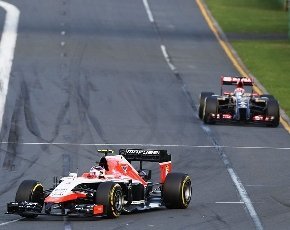Marussia F1 Team keeps racing with Sage partner expertise
Software specialists discuss how bespoke tailored apps successfully augment Sage ERP X3 sales into midmarket customers such as the Marussia Formula 1 Team
With customer expectations growing ever greater and more complex, software resellers should consider beefing up their own research and development activities in order to offer complementary, bespoke offerings and bring something a bit different to the table.
That was one of a number of conclusions drawn at a frank discussion between Sage partners and customers held at the UK headquarters of the Marussia F1 Team.

The Tyneside-based ERP vendor has around 18,000 midmarket customers in Europe and is keen to get the channel focused on what Sage midmarket European strategy and comms director, Jayne Archbold, describes as the “unsung heroes of the economy”.
Lighthouse account customer Marussia F1 Team entered the world of Formula One as Virgin Racing in 2010, taking on its new identity following the acquisition of a controlling stake in the team by Moscow-based Marussia Motors in 2012, although the two have since split.
Although its results to date have been less than stellar in the hyper-competitive world of Formula One, Marussia has its sights set on breaking into the midfield, and is currently outperforming main rival Caterham. With the inaugural Russian Grand Prix still on track to take place in Sochi later this year in spite of recent political events, the team is putting itself under increasing pressure to deliver results both on and off the circuit.
Marussia operations manager Kevin Lee explains: “We always do everything we can to move quickly. For us the race, so to speak, is to get the components made and onto the car as soon as possible. An ERP system is critical to keep control of the financing, manufacturing and lifecycle of all the components on the car.
“Our whole world is geared around going faster, not just the car but the business processes, too. We’ll always come back to making it more efficient – we have a long list of items where we want to move forward but we have to balance that against our investment.
“[In technology partners] we need reliability and robustness and the ability to support – often we are working 24 hours a day, when the team is in Australia, for example. We send approximately 70 people to 20 races every year – they consume a lot of reports generated from the ERP system and have access to it offsite,” says Lee.
The scale of some of the challenges facing a midmarket business like Marussia become plain to see on taking a tour of its factory – located on an unassuming industrial park on the outskirts of Banbury.
The team has been successful in outsourcing substantial parts of its operation to bigger players – it currently takes its engines from Ferrari and has cut a deal with McLaren on some aspects of testing – but also relies on a network of specialist British automotive engineering firms, many based in the F1 ‘heartland’ between Oxford and Milton Keynes. The importance of clear and concise supply chain management is therefore obvious.
Perhaps more importantly, the comparatively cash-strapped Marussia employs a fraction of the staff of some of the larger teams such as McLaren or Mercedes. In some cases one man performs the function of over 20 Red Bull employees. Marussia is very proud of its pared back working practices, and it demonstrates neatly the oft quoted channel mantra of helping customers do more with less. The team’s systems need to work well and work right all the time to get its cars out of the factory doors and onto a truck just to go a few miles down the road to Silverstone, let alone Melbourne, Shanghai or São Paulo.
To handle its intensive demands, Marussia teamed up with Sage to deploy Sage ERP X3 two years ago in a direct relationship, but recognising the highly-specialist – some might say ‘rather unique’ requirements of a Formula 1 team – since then Sage has sub-contracted some aspects of the deployment to Hampshire-based partner Mysoft.
“We have a good team of developers with extensive understanding of X3, both on the ERP solution and a developer environment,” says Mysoft director Chris Schafer.
“Some customers, rather than take the product out of the box, we can tailor software to their specific requirements. Marussia had specific requirements and Sage contracted that work back to us,” he continues.
For Schafer, meeting the expectations of firms such as Marussia can be challenging. “It’s difficult to keep abreast – there is so much technology and we have to identify what customers can benefit from,” he explains, “so for us it is really a question of separating the wheat from the chaff, and deciding which software applications can really deliver.”
Tailored developments around key vendors such as Sage help businesses like Schafer’s find small, incremental advantages when targeting midmarket customers, he says.
Sage and Marussia F1 Team
- The implementation of Sage ERP X3 at Marussia took just eight weeks from conception to operation
- During the implementation process, 5,000 product codes and 2,800 purchase order lines were imported to Sage ERP X3.
- In 2013, approximately 16,500 lines in MR02 BoM, 44,700 purchase order lines, 40,700 invoiced lines and 1,750 suppliers from 30 countries in nine different currencies were entered into the system.
- The implementation has given Marussia 100% control and visibility of all car parts during their lifecycle, from engineering drawings to supplier invoicing.
- So far, the system installed for Marussia has experienced no unplanned downtime.
- During the 2012 F1 season, Marussia deployed 20 major development upgrades to its car, creating and building new parts for each event, from the opening race in Australia to the season climax in Brazil.
- Marussia has managed an eight figure annual spend through Sage ERP X3, and in 2012 came in 1.19% under budget.
- Its 2013 car was built entirely in Sage ERP X3, activating more modules such as BoM and Works Orders.
- In an indication of the reliability attained, 2013 rookie Max Chilton finished 20 out of 20 races, and so far has finished every race in the 2014 season as well.
Although Marussia and Mysoft are prevented from revealing details of what functions its tweaks around Sage ERP X3 were designed to enhance, another Mysoft success story comes in the shape of cycling channel distie Madison, which supplies kit and components from names such as Garmin, Pearl Izumi and Shimano to independent bike retailers around the country, and has recently branched out into developing its own lines.
Madison IT manager Graham Trent also took advantage of Mysoft’s complementary development capabilities to help streamline the firm’s ordering systems to combine orders.
“Combining orders saved us money and our customers are happy because they do not have to deal with getting boxes and boxes daily. I don’t know of any ERP system that does that itself, but Mysoft did it for us,” he says.
Chris Stock, managing director of Cheshire-based Sage and Oracle partner Percipient, specialises in life sciences, pharma and chemical industry customers, all areas that frequently require additional expertise. He says the price point, functionality and ease of use that he has found with Sage make it ideal for such customers.
“It has lower cost of ownership, is easy to implement and use, it demos well and overall it’s a great product to look at: people get turned off when they see a clunky product but this is very role-based and customers can quickly and easily see how their lives will look in Sage,” he says.
Simon Gorman, Sage midmarket European GM of HR and payroll, says he sees more and more customers demanding expansion of workflow and scope on top of what the vendor is able to offer.
“The need for channel partners to add more value and the ability to present that value to the customer in an easy, seamless way, with short times to delivery, is vital,” says Gorman.
Jayne Archbold adds: “As a vendor this means we need to be ever clearer around future roadmaps, to demonstrate what Sage is going to deliver.”
While midmarket businesses with the profile and demands of the Marussia F1 Team are uncommon in the UK, in the same way that Formula 1 serves as a development and testing ground for innovations that later find their way into our daily lives – the Kinetic Energy Recovery System (KERS) developed for F1 is now in use in public transport systems and renewable power stations – so the lessons learned by partners in dealing with such businesses can be applied to enhancing the experience for all midmarket customers.
After all, as Sage’s Gorman concludes: “Customer expectations are higher and higher, and partners must be part of that changing dynamic.”










